The frequency of bathing a dog can vary based on several factors, including breed, coat type, and activity level. Most dogs should be bathed every four to six weeks, but some may require more or less frequent baths depending on their lifestyle and skin condition. Regular grooming can also play a significant role in reducing the need for frequent baths and maintaining overall hygiene.
For example, dogs with oily coats, like Basset Hounds, may benefit from more frequent baths, while those with dry skin may need less frequent bathing. Additionally, dogs that spend a lot of time outdoors or have skin conditions may require adjustments to their bathing schedule.
Understanding these nuances helps pet owners maintain their dogs' health and comfort. By finding the right bathing routine, owners can ensure their pets remain clean without compromising their skin and coat health.
Assessing Your Dog's Bathing Needs
Determining how often to bathe a dog involves several key factors. Both the dog's individual characteristics and breed considerations play significant roles in establishing a suitable bathing schedule.
Factors Determining Bathing Frequency
Several factors influence how frequently a dog should be bathed. Activity Level: Active dogs that spend time outdoors may require more frequent baths due to dirt and odors. Coat Type: Dogs with oily coats may need baths more often than those with dry hair. Health Considerations: Skin conditions and allergies can dictate a bathing schedule recommended by a veterinarian.
Age is another factor; puppies may need less frequent baths, while older dogs can require more due to mobility issues. Environment also matters; dogs living in rural areas might need extra cleaning compared to city dwellers. It's essential to monitor the dog's condition regularly to adapt to any changes.
Breed-Specific Bathing Considerations
Each breed has unique grooming requirements affecting bathing frequency. Long-Haired Breeds: Breeds like Afghan Hounds or Maltese typically need baths every 4-6 weeks to prevent matting and tangles.
Short-Haired Breeds: Breeds such as Beagles or Boxers often only need baths every 6-12 weeks, as they do not collect as much dirt. Hypoallergenic Breeds: Dogs like Poodles should be bathed regularly to manage skin health but may require less frequent washing than one might expect due to reduced shedding.
Owners should also consider skin sensitivity common in certain breeds. For instance, bulldogs often have skin folds that require careful cleaning to avoid irritation. Understanding these breed-specific needs helps ensure a dog's skin and coat remain healthy.
Selecting the Right Bathing Products
Choosing appropriate bathing products is essential for maintaining a dog’s health and coat condition. The right shampoos and accessories can enhance the bathing experience while ensuring that the dog’s skin remains healthy and free from irritants.
Understanding Dog Shampoos
Dog shampoos are formulated specifically for canine skin, which is different from human skin. Owners should look for products that are free from harsh chemicals, such as sulfates and parabens. These ingredients can irritate a dog’s skin.
Key Ingredients to Consider:
- Oatmeal: Soothes itchiness and inflamed skin.
- Aloe Vera: Moisturizes and helps in healing minor irritations.
- Tea Tree Oil: Offers antibacterial properties but should be used with caution, as some dogs may be sensitive.
It is crucial to choose a shampoo based on the dog's coat type. For example, a dog with a thick, double-layer coat may benefit from a shampoo designed for that particular fur type. Always perform a patch test when trying a new product to ensure there’s no allergic reaction.
Conditioners and Other Bathing Accessories
Conditioners can significantly improve coat texture and manageability. For dogs with long or thick fur, using a conditioner helps detangle and reduce mats. Choose a conditioner that aligns with the dog’s specific coat needs.
Additional Bathing Accessories:
- Brushes: A good brush can remove loose hair and help distribute natural oils.
- Bath Mats: These can prevent slipping and ensure the dog feels secure during bath time.
- Towels: Microfiber towels are effective for quick drying and are gentle on the skin.
When selecting bathing accessories, consider the size and temperament of the dog. Ensuring comfort during bathing will help make the process less stressful for both the dog and the owner.
Bathing Techniques and Best Practices
Proper bathing techniques and best practices ensure a safe and effective cleaning process for dogs. Preparation, step-by-step procedures, and post-bath care are essential to promote a positive bathing experience.
Preparing for the Bath
Before starting the bath, gather all necessary supplies. This includes dog shampoo, conditioner, towels, a non-slip mat, and a brush. A sprayer or a cup can also be helpful for rinsing.
It’s best to choose a location that is comfortable for both the dog and the owner. For smaller breeds, a sink or tub works well, while larger dogs may need a spacious bathtub or outdoor area. Ensuring the water temperature is lukewarm helps the dog feel comfortable and relaxed during the process.
Brushing the dog's coat before the bath can remove loose fur and mats, making the bath more effective. A calm environment will assist in reducing any anxiety the dog may feel about bathing.
Bathing Steps and Procedures
Begin by wetting the dog’s coat thoroughly. Use a sprayer or a cup to apply water, avoiding the dog's face and ears initially. Next, apply an appropriate shampoo, lathering gently and ensuring it penetrates the fur without being harsh on the skin.
Rinse the shampoo completely to prevent residue build-up. Apply conditioner if needed, then rinse again. Be cautious around sensitive areas such as the eyes, ears, and nose.
For dogs that are anxious, consider using calming techniques such as a soothing voice or treats. This helps create a more positive bathing experience. Maintain a steady pace to keep the dog calm throughout the process.
Post-Bath Care
After rinsing, gently towel-dry the dog to remove excess moisture. Depending on the breed, a blow dryer on a low setting can help, but be cautious not to startle the dog.
Drying the ears thoroughly is crucial to prevent infections. If the dog has long fur, a comb or brush can help prevent tangles and mats.
Also, observe the dog's skin and coat for any unusual signs, such as redness or irritation, which may need veterinary attention. Regular post-bath grooming promotes a healthy coat and reinforces the bond between the dog and owner.
Understanding the Risks of Over-Bathing
Bathing a dog too frequently can lead to several health issues. It's essential to strike a balance to maintain their coat and skin health.
Common Risks of Over-Bathing:
- Skin Irritation: Frequent baths can strip natural oils, leading to dryness and irritation.
- Allergic Reactions: Over-bathing can make a dog more susceptible to allergies due to an unbalanced skin barrier.
- Seborrhea: This condition causes oily or flaky skin, potentially exacerbated by excessive bathing.
Signs of Over-Bathing:
- Flaky Skin: Noticeable dryness or flakes might indicate the skin's natural moisture has been compromised.
- Odor: Ironically, a dog that smells bad may be over-bathed, as natural oils help combat odors.
- Dull Coat: A lack of shine can signify excessive cleansing, which removes essential oils.
It's crucial to understand that every dog is different. Factors such as breed, activity level, and environment affect how often a dog should be bathed.
Regular grooming, including brushing, can help reduce the need for baths. Proper grooming removes dirt and loose fur without harming the skin's natural oils.








